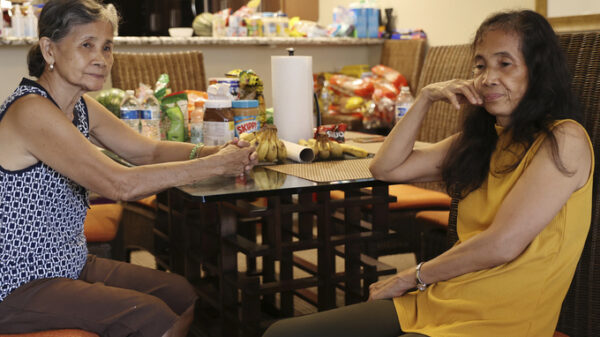Paige Pritchard, a spending coach who shares financial advice on TikTok, poses for a photo in her home office, Thursday, Feb. 9, 2023, in Coppell, Texas. At a time when consumers are inundated with so-called social media influencers peddling the latest products online, a slew of TikTok users are leveraging their platforms to tell people what not to buy instead. Pritchard said she chose her career path after blowing her entire $60,000 salary on clothing, beauty and hair products in the first year after she graduated from college. (AP Photo/Tony Gutierrez)
NEW YORK (AP) — At a time when consumers are inundated with so-called social media influencers peddling the latest products online, a slew of TikTok users are leveraging their platforms to tell people what not to buy instead.
The trend, called “de-influencing,” is a stark contrast to prior ones like #TikTokMadeMeBuyIt, when consumers were showing off products they purchased after seeing them on the social media app.
These days, TikTokers are telling their followers which products aren’t worth the money, or urging them to resist indulging in trends. Some influencers are sounding off about blushes, mascaras or other beauty and skincare items that made big promises but don’t deliver. And others are telling their followers to avoid hair stylers and water bottles TikTok itself helped popularize.
All told, clips with the hashtag #deinfluencing have racked up more than 150 million views in just a few months. It’s not clear how the trend originated, though one of the first TikTok videos came from a former employee for Ulta and Sephora, who listed frequently-returned products at the beauty stores.
Paige Pritchard, 33, said it’s refreshing to see consumers finally having this conversation. Now a spending coach who shares financial advice on TikTok, Pritchard said she chose her career path after blowing her entire $60,000 salary on clothing, beauty and hair products in the first year after she graduated from college.
At the time, Pritchard was living with her parents to help pay off her student loans. But heeding recommendations from YouTube influencers, who routinely get paid by brands to market products, she regularly went to Nordstrom or J. Crew on her lunch breaks, easily dropping $500 per visit.
“When it came time to move out, I realized that I had no money,” Pritchard said. “I could barely afford to move out of my parent’s house at the end of that year.”
She felt embarrassed and ashamed, and characterizes the moment as her “breaking point.”
Estefany Teran, 23, said she was inspired to make her “de-influencing” video after her sister-in-law told her she wanted a Stanley cup — a popular 40-ounce drinking tumbler that recently went viral on TikTok. But it was out of stock.
“I was like, ‘You can just go to TJ Maxx and get a different cup,’” Teran said.
TikTok trends come and go, and criticisms of consumerism aren’t necessarily new. Still, influencers who hop on the de-influencing trend could be seen as more trustworthy and use the opportunity to shore up credibility, said Abhisek Kunar, a marketing lecturer at the University of Essex who has studied how Gen Z interacts with content creators.
A study he did with other academics showed Gen Z shoppers typically ignore influencer campaigns they believe to be controlled by companies. Brand deals and influencers have become almost synonymous over the years, but consumers still crave authenticity and those seen as inauthentic often incur a cost to their reputation.
Most recently, Mikayla Nogueira, a makeup artist with 14.4 million TikTok followers, was accused of wearing fake eyelashes while promoting a L’Oreal mascara in a sponsored video by the brand. (Representatives for Nogueira did not reply to a request for comment.)
“Influencers will still remain relevant, but one of their major weapons — which is source credibility — is slowly getting eroded unless they do something about it,” Kunar said.
The temptation to make money, however, can be hard to overcome. Many influencers earn their living from the content they produce, oftentimes in collaboration with brands. Such partnerships have exploded in the past decade, according to Influencer Marketing Hub, which says the influencer marketing industry reached over $16 billion last year, up from $1.6 billion in 2016. At the same time, the number of people who search for products on social media has risen by 43% since 2015, the audience research company GWI said in a recent report.
Compared to other influencer-dominant platforms like Instagram and YouTube, TikTok is fairly new to driving consumer behavior. But traction there has driven sales on many items, including books by Texas-based writer Colleen Hoover as well as products that can supposedly give the skin a glistening and plump finish known as “dolphin skin.”
Data from the market research company NPD Group also shows purchasing decisions on skincare and fragrance products, in particular, were influenced more by TikTok last year compared with 2021.
De-influencing — much like influencing — sprang from a place of authenticity. But the longer the trend lingers, the more it becomes something of a paradox: The hashtag is being used by some users to pan certain products and then turn around and offer up alternatives — essentially influencing their followers to buy more items, not less.
And there might be money to be made in that as well. For example, some products mentioned in popular TikToker user alyssastephanie’s de-influencing videos are listed on her Amazon Storefront, a personalized page on the e-commerce site where influencers earn commission from purchases made using affiliate links. TikToker valeriafride, whose de-influencing video got more than a million views, also has recommendations listed on her Storefront.
Fride has a caption that tells viewers to not buy everything mentioned in her video. She told The Associated Press in an emailed response that she hasn’t made and “didn’t intend to” make money off of the alternative products she recommended, but did not provide further details. TikToker alyssastephanie said in an email that having a Storefront makes it easier for viewers to find items mentioned in a clip.
Mandy Lee, a fashion critic and freelance writer who posted a TikTok video championing the anti-consumption trend, said she would be skeptical of any influencer who is participating in this conversation for the first time because its a trend.
“It’s hard for me to trust someone who’s never done a nuanced take about products before, and suddenly they’re doing it now,” said Lee, who lives in Brooklyn, New York and has another side job consulting companies about fashion trends. “I would question whether or not it’s genuine.”
Copyright 2021 Associated Press. All rights reserved.
Source: https://apnews.com/article/technology-business-27e6f62051b887b005ef79c8b455b11a










































